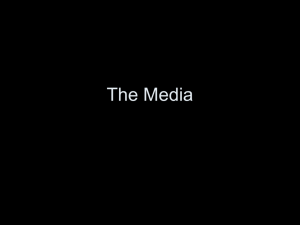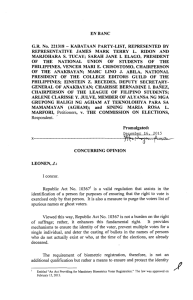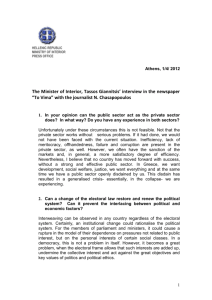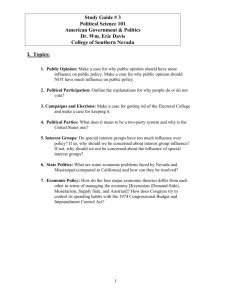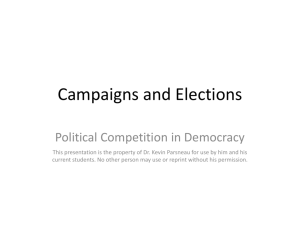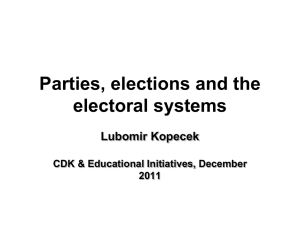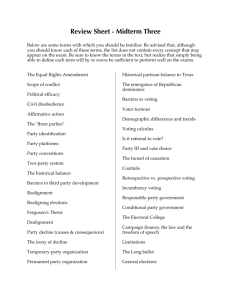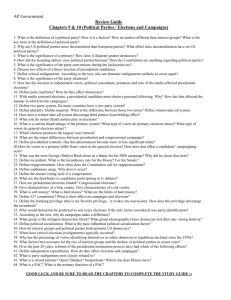Linkage Institution- are the structures within a society that connect
advertisement
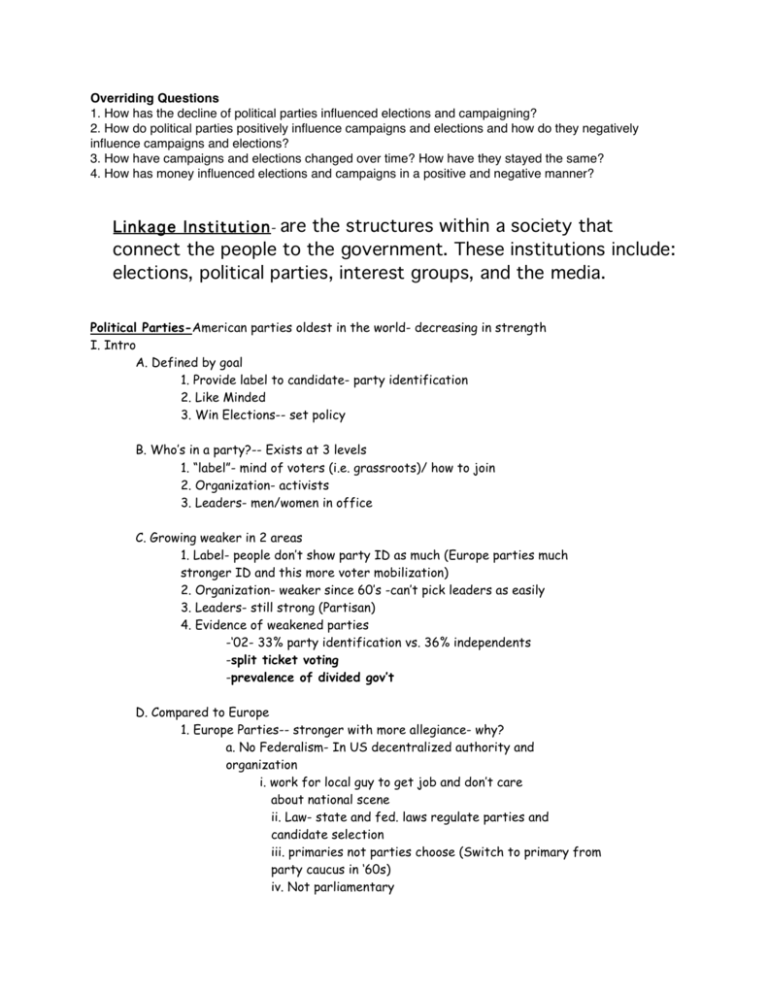
Overriding Questions 1. How has the decline of political parties influenced elections and campaigning? 2. How do political parties positively influence campaigns and elections and how do they negatively influence campaigns and elections? 3. How have campaigns and elections changed over time? How have they stayed the same? 4. How has money influenced elections and campaigns in a positive and negative manner? Linkage Institution - are the structures within a society that connect the people to the government. These institutions include: elections, political parties, interest groups, and the media. Political Parties-American parties oldest in the world- decreasing in strength I. Intro A. Defined by goal 1. Provide label to candidate- party identification 2. Like Minded 3. Win Elections-- set policy B. Who’s in a party?-- Exists at 3 levels 1. “label”- mind of voters (i.e. grassroots)/ how to join 2. Organization- activists 3. Leaders- men/women in office C. Growing weaker in 2 areas 1. Label- people don’t show party ID as much (Europe parties much stronger ID and this more voter mobilization) 2. Organization- weaker since 60’s -can’t pick leaders as easily 3. Leaders- still strong (Partisan) 4. Evidence of weakened parties -‘02- 33% party identification vs. 36% independents -split ticket voting -prevalence of divided gov’t D. Compared to Europe 1. Europe Parties-- stronger with more allegiance- why? a. No Federalism- In US decentralized authority and organization i. work for local guy to get job and don’t care about national scene ii. Law- state and fed. laws regulate parties and candidate selection iii. primaries not parties choose (Switch to primary from party caucus in ‘60s) iv. Not parliamentary b. Intense Partisanship- we don’t like it (Clinton Trial) c. No primary system- to become a candidate in Europe you must convince party leaders to put your name on the ballot d. In Europe pay dues and go to meetings for party vs. US just vote with party II. History of Parties A. Begins with Jefferson- Hamilton (TOP-DOWN PARTY) 1. Federalist and Anti-Fed’s (Dem-Rep) III. The 2 Party System A. America 1. Plurality System- Winner Take All a. Lincoln- 39% b. Clinton-43% 2. Electoral College a. Perot- 19% popular vote- no electoral votes 3. ** To get plurality you need coalition 4. American Voter a. Tradition- If it isn’t broke don’t fix it b. Ease c. Don’t like extremes B. Europe 1. Need majority so a. Run-off Elections or b. Proportional Rep. c. Result-- Minor parties can get seats C. Minor Parties in America 1. Generally unsuccessful electorally 2. Policy co-opted by major parties 3. Fail- “wasted vote” IV. Parties Today A. Basic Structure -National Chairman- chosen by --runs--National Committee | -made up of delegates from states handle party affairs & plan -National Convention (meet to pick (nominate) candidate -Congressional Committee- Aid Congressmen in reelect & getting elected B. Effectiveness 1. About same til Rep. in 60-70s organize better a. Raise more $ b. Win seat & President (‘68, ‘72, ‘80, ‘84, ‘88) & Congress (‘94) 2. Democrat Meanwhile Factionalize Within Selves- Distribute power within party a. Lose elections b. Later catch up with media 3. Both Weakening- Since FDR and advent of modern Presidency & Progressive Reforms a. More Independents- less grassroots support b. Convention- not important as nominating device c. Try to appeal to more extremes -Rep.- more conservative -Dem.-more liberal d. Shift to primary e. Initiative and Referendum- Progressive reform that takes away power of party and gives to people C. Local Groups Within Parties 1. Machines- Party loyalty based on patronage (They create voting blocs not that parties need to win) a. Limited by Hatch Act (‘39)-- no federal employees work for camp (conflict of interests) b. Spreads to localities where participation is high until-1. Educated- people reject party machines 2. Welfare- don’t need the party anymore 2. Ideological Party- Can be pure a. Factions within party or small clubs 1. Pro-life, Environment, Women b. Parties are no coalitions of small groups 3. Solidarity Group a. Hard core political junkies -weakly organized but active voters 4. Sponsored Party a. when committee organized creates a party- voting bloc b. Unions 5. Personal Following a. Charisma creates voting bloc (Bush in 2000, Reagan) V. How Parties Nominate A President Candidate -To Win- Build Coalition, No favorites among factions A. In day of strong party caucus chose nominee 1. Electoral Objective win-- “electable guy” 2. Policy Objective win-- “Don’t worry” about these B. Now coalitions of small group puts policy ahead of electoral objective C. Delegates at convention wind up more extreme than voters- why? 1. Usually elites voting in primary or caucuses = extremes chosen 2. Delegated are extremists/ policy oriented they want to be heard more than rank and file members 3. Now we have a different nominating process from 60s 4. Ideological motivated activists at Convention vs. more moderate voters 5. Explains why democrats choose poor (extremist) candidate & lose so much! VI. Party Realignment or Critical Elections A. Alternation of one party dominance to the other party B. Critical Election- sharp, lasting shift occurs in the popular coalition supporting one or both parties- the issues that separate the parties change and so do the party supporters C. 5 Critical Relalignments in history (1800, 1828, 1860, 1896, 1932) D. Critical Realignment for the Republicans in ‘94????- or is it party dealignment because parties have become so weak??? Some facts worth noting... -TREND- the political parties in recent years- the democrats have become more liberal, and the Republicans have become more conservative - a prime example of this is-- during the primary elections, the candidates behave more liberal in the democratic party and more conservative in the republican primary in order to secure the support of the party “regulars” for their nomination whereas in the general election the candidates tend to behave more moderate and temper their views from the primaries in order to gain support of the growing independents, split-ticket voters, and anxious middle (radical middle) and take the mainstream view - What are some differences between Congressional and Presidential elections? 1. Funding (public vs. private) 2. Voter Turnout -Some differences between the republicans and democrats -Fundraising -Ideological differences

